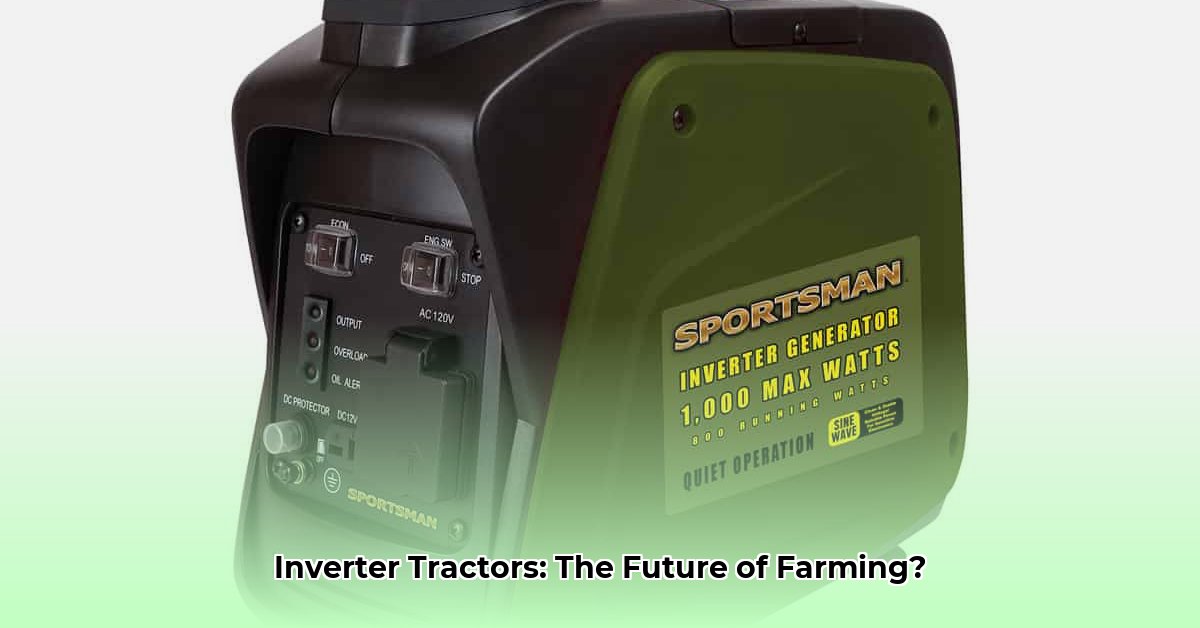
Choosing the right power source is critical for modern farming. It impacts both your bottom line and your environmental footprint. Inverter tractor power systems offer a smart solution, balancing efficiency with sustainability. This guide explores how inverters can benefit your farm. For more on tractor implements, check out this helpful resource: tractor implements.
Understanding Inverter Types: Pure Sine vs. Modified Sine Wave
Inverters convert direct current (DC) electricity (from solar panels or batteries) into alternating current (AC) electricity needed by most farm equipment. Two main types exist:
Pure Sine Wave Inverters: These produce a clean, smooth AC power supply, ideal for sensitive electronics like milking machines and automated systems. They are more expensive but offer superior reliability. Think of it as a consistently flowing river of power.
Modified Sine Wave Inverters: These are cheaper but produce a less consistent power supply. Suitable for less-demanding equipment like electric fences, but may damage sensitive electronics over time. This is more like a river with some rapids in it.
The choice depends on your equipment and budget. For sensitive equipment, a pure sine wave inverter is essential. For simpler tools, a modified sine wave might suffice. Always check your equipment's power requirements before purchasing an inverter.
Harnessing the Sun and Wind: Benefits of Inverter Systems in Sustainable Agriculture
Inverters offer numerous advantages:
Renewable Energy Integration: Use renewable sources like solar and wind power, reducing reliance on fossil fuels and lowering your carbon footprint. Isn't that a goal for every sustainable farm?
Energy Efficiency: Inverters only supply the power actively used, unlike traditional generators that constantly run, wasting energy and fuel. This translates directly to cost savings.
Quieter Operation: Inverters operate much more quietly than noisy generators, creating a more peaceful environment. Do you need to worry about disturbing neighbours? Not with an inverter.
Reduced Maintenance: Often requiring less maintenance than gasoline-powered generators, saving you time and money.
Choosing the Right Inverter: A Step-by-Step Guide
Calculate Power Needs: List all equipment used simultaneously and find their wattage ratings (usually on a label). Add these wattages together.
Add a Safety Margin: Add 20-30% to the total wattage to prevent overloading during power surges. This is a crucial step often overlooked.
Consider Your Budget: Pure sine wave inverters cost more but offer superior reliability. Choose an option that balances your needs and budget.
Future Needs: Plan for potential equipment additions. Choose an inverter with extra capacity to avoid future replacements.
Research and Recommendations: Check online reviews and seek advice from other farmers.
Power Requirements of Common Farm Equipment:
| Equipment | Wattage Range (Approx.) | Inverter Type Suggestion |
|---|---|---|
| Milking Machine | 1500-3000 Watts | Pure Sine Wave |
| Irrigation Pump | 2000-7000 Watts | Pure Sine Wave |
| Electric Fence | 50-200 Watts | Modified or Pure Sine Wave |
| Small Tools | 100-500 Watts | Modified Sine Wave |
Installation and Maintenance: Ensuring Long-Term Performance
Proper installation is paramount for safety and longevity. Always follow manufacturer instructions carefully. Ensure proper grounding and adequate ventilation to prevent overheating. Regular maintenance, including cleaning terminals and inspecting connections, is essential for optimal performance. How much time do you realistically have for maintenance? Choose the solution that matches your operational style.
Cost-Benefit Analysis: The Long-Term Picture
While the initial cost of an inverter can seem high, long-term savings are significant:
Pros: Reduced fuel costs, lower maintenance, lower carbon footprint, quieter operation, and potential government incentives.
Cons: Higher upfront cost, slightly increased setup complexity.
The long-term cost savings and environmental benefits usually outweigh the initial investment making it a sustainable choice.
Real-World Success Stories: Farmers Leading the Way
Many farmers successfully use inverter systems. These real-world examples demonstrate the practical applications and the positive impact on their operations.
The Future of Farm Power: Ongoing Research and Development
Ongoing research continuously improves inverter technology and renewable energy integration in agriculture. Advancements in battery technology, solar panel efficiency, and smart power management systems promise further cost-effectiveness and efficiency gains. Staying updated on these developments is crucial for maximizing the benefits to your farm. Choosing the right power system is a critical step toward a sustainable and profitable future for your farm.
How to Choose the Best Inverter Generator for Sustainable Farming
Key Takeaways:
- Inverter generators offer substantial advantages in sustainable farming.
- Power needs, fuel type, and budget are crucial factors in inverter generator selection.
- Proper maintenance ensures efficient long-term operation and minimizes environmental impact.
- Integrating renewable energy significantly reduces reliance on fossil fuels.
Choosing the right inverter generator is key for efficient and environmentally friendly farming. Remember to consider the long-term implications of your decision and make the choice best suited to your unique circumstances.